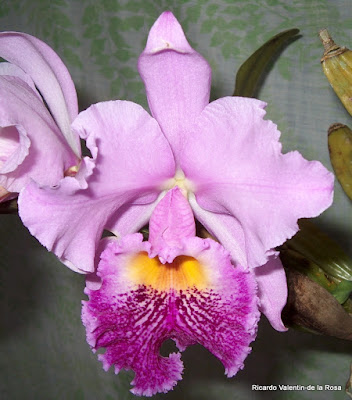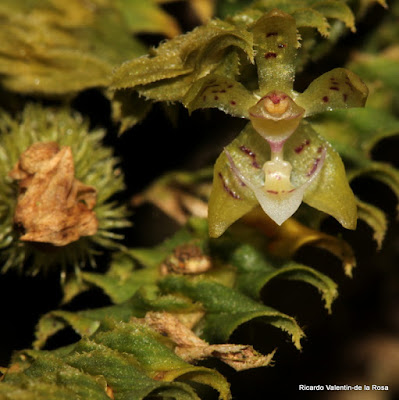Friday, November 20, 2015
Dendrobium bullenianum Rchb.f 1862, first flowers in my garden
I have found that this Dendrobium is easy to cultivate in Puerto Rico. The plant needs a well drained medium, abundant watering and regular fertilizing to produce its long canes. It does equally well in the coast and in the mountains. Where I live, at 1000 feet of altitude temperatures only go under 60F at night during a short spell in winter, it doesn't seem to bother this plant. I prefer to cultivate upside down like I do my Den. anosmum so that the mature canes hang down as they do in nature. This is the first blooming of this species for me, the plant is still small and young. I expect that when it reaches its adult size it will produce its characteristic many flowered globular inflorescences.
Labels:
bullenianum,
Dendrobium,
orchid,
orchidee,
orquidea,
pedilonium,
pendent,
red,
species,
topaziacum,
yellow
Saturday, October 31, 2015
Sunday, October 18, 2015
Cranichis tenuis Reichenbach f. 1865, the population I found in the landslide last year has become larger
Last year I found a few plants of this species growing in nooks and crannies among the rocks of a decades old landslide. In this year blooming season I found many more plants than last year. It seems the conditions at the landslide site has become favorable for the growth of this orchid.
Saturday, October 3, 2015
Anolis gundlachi, the yellow chinned anolis in El Yunque forest, Puerto Rico
I saw this Anolis in el Yunque forest. The anolis was in a shady area under the canopy. It kept moving away and hiding which didn't make taking his photos any easier.
Gonatista grisea, a mantis, seen in the Rio Abajo forest, Puerto Rico
A friend, Alberto Alvarez, noticed this mantis had come into one of the Department of Natural and Environmental resources buildings in the forest. We took photos of the insect and after that firmly but in a gentle manner, invited the mantis to leave the inside of the building and return to the forest. We were successful in this. No mantis were harmed during the taking of these photos.
Dichaea hystricina Rchb. f. 1865 found with multiple blooms "in situ" in El Yunque forest, Puerto Rico.
Yesterday I went hiking in El Yunque forest, in the east of the island of Puerto Rico. The weather was outstandingly horrid for macro photography. Wind gusts at times seemed to reach tropical storm strength. At times it was raining, then sunny, then raining again or drizzling or raining lightly and it changed all the time. Then there was fog and 100% humidity. But who says one has to go out to take photos only in nice weather?
For years now I had missed the peak blooming of Dichaea, but yesterday I hit the jackpot, I found several plants with flowers. Unfortunately, taking photos of the flowers proved challenging due to the wind gusts and the constant rain. Also I had to change lenses, a nightmarish thing to do under such conditions and only having the tiniest rain coat on. Nevertheless I managed to snap a few acceptable photos.
A thing saddened me, it is clear many of the plants succumbed to the long spell of unusually dry weather earlier in the year. This species was very common near Mount Britton. Now only a fraction of the previous population remains in the area. Other species appear to have fared even worse. I could not find Lepanthes in areas where they were quite common, not even a single plant.
Thursday, October 1, 2015
Tolumnia variegata "in situ" in the Rio Abajo Forest, Puerto Rico, a plant that I have been watching since last year.
I have been watching this plant since last year when I spotted it blooming in September. The plant is growing exposed to full sun in a decaying branch. This year has been hard on this plant, there was a prolonged spell of lower rainfall during what is normally one of the wettest periods of the year. This year's growths are smaller and look yellower and wrinkled in comparison with the relatively larger and plumper growths it had in 2014. The inflorescences are smaller and have fewer flowers. However this year it has produced more inflorescences than in 2014. The branch where this orchid grows is dead and is decaying, it remains to be seen if it will last for another year. It is not uncommon, as one walks thorough the forest after a storm, to find branches broken by the wind. It may be that this will be the fate of this branch. Should this happen I will relocate the plant to another branch in the same tree.
Wednesday, September 16, 2015
Monday, September 14, 2015
Sobralia sp.
I brought this plant a few years ago at a local orchid show. I have no idea as of the identification of this plant. It grows well in a mix of compost, sand and red laterite soil. The flowers last a single day.
Thursday, August 20, 2015
Thursday, August 6, 2015
Psychilis monensis Sauleda 1988, a pink flower
There are vast populations of this orchid in Mona Island, between Puerto Rico and Hispaniola. There is some variation in the color of the flowers. I found this pink flower deep in the forests of the east part of the island. Most flowers of this species have either greenish or pale cream or yellow flower segments.
Tuesday, August 4, 2015
Vanilla poitaei Rchb. f. 1877 "in situ",
This orchid is endemic of the Bahamas and the Greater Antilles. In
Puerto Rico this orchid is not particularly rare, however few local people, and
this includes most orchid growers, are familiar with this plant and its
flowers. I have seen this plant hanging from trees
near roads and snaking through the ground in sharp slopes but only very rarely
have seen inflorescences and until now, I had never seen the flowers.
A few years back I located a large plant of this species
growing in the trees close to the edge of a wetland. A careful examination of the stems proved
highly disappointing, as I could not locate evidence that it had ever
bloomed. The plant is enormous, a real
giant, some stems measure tens of feet and descend all the way to the ground
from the canopy. Other stems are draped
over bushes and small trees a few are growing directly on the ground but are attempting
to climb back into the trees.
I kept returning to the plant each summer to see if it had
bloomed. Last year, to my chagrin, I
found that I had completely missed the blooming season, which happens in
July. This year I almost missed it too
but in this case because I was on vacation, away from the forest, during the
peak of the blooming.
Although the plant, or plants, it is hard to tell given the
way the stems are tangled, is quite large, it only blooms in the section of the
plant that is facing an opening of the canopy in the direction of the edge of
the wetland. The plant produced about
ten inflorescences in this small section and none at all in all the stems that
were in the deep shade. The flowers
are ephemeral and last in perfection a single day. I found a developing seed capsule in one of
the inflorescences, none in the others, but there are still a few that have not
yet bloomed so there is the possibility the plant will produce additional
capsules.
I will keep visiting this plant to see if I can take photos
of other flowers and to check how many seed capsules it produces by the end of
the blooming season.
Thursday, July 23, 2015
Psychilis monensis, an orange yellow form of this variable species, photographed "in situ" very deep into the interior of Mona Island.
This orchid is locally common, and sometimes downright abundant in certain parts of Mona Island. This species produces flowers that can vary in color and markings between different plants. This particular plant has orange yellow floral segments framing a richly colored lip.
Subscribe to:
Comments (Atom)




























































